|
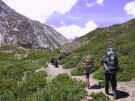 Namaste! Nepal was recently voted by travelers in
Namaste! Nepal was recently voted by travelers in
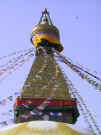 150
countries as the # 2 country to visit, just being beat out by New
Zealand. Nepal has 8 out of the 14 highest mountains in the world which
provides excellent outdoor activities: trekking, hiking, white water
rafting, kayaking. It also has a beautiful sense of architecture in the
areas in and around Kathmandu (in Patan and
Bhachtapur) with high buttresses and
magnificently carved figures throughout the woodwork. The country is
situated between India and Tibet,
so it’s a mixture of both Hindi and Buddhist cultures, but without any
strife whatsoever. Buddhist statues and stupas (temple sort of thing)
lay on the same spot as Hindu statues and temples. Nepal is also the
only Hindu kingdom in the world, but the Buddhist cultures seems more
visible to us as tourists. 150
countries as the # 2 country to visit, just being beat out by New
Zealand. Nepal has 8 out of the 14 highest mountains in the world which
provides excellent outdoor activities: trekking, hiking, white water
rafting, kayaking. It also has a beautiful sense of architecture in the
areas in and around Kathmandu (in Patan and
Bhachtapur) with high buttresses and
magnificently carved figures throughout the woodwork. The country is
situated between India and Tibet,
so it’s a mixture of both Hindi and Buddhist cultures, but without any
strife whatsoever. Buddhist statues and stupas (temple sort of thing)
lay on the same spot as Hindu statues and temples. Nepal is also the
only Hindu kingdom in the world, but the Buddhist cultures seems more
visible to us as tourists.
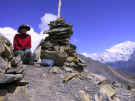 Going
to Nepal to trek in the mountains was one of the “must do” items
along with African Safari.
We were told by everyone who has traveled extensively that Nepal and
trekking were one of their most enjoyable experiences. Well, that
sounded good enough for us. But, all we could gather was we would just
go for a long walk in the mountains (not climbing) for days or weeks on
end and stay in local “tea houses” along the way. We would also see
the traditional villages and culture that is pretty unchanged for
thousands of years. What we didn’t know was that we were setting out
for the highest walking pass in the world at 5,415 meters (17,799 feet)
which is higher than any mountain in Europe and the oxygen content is ˝
that at sea level. This is also a very common place for people to die
every year from altitude sickness. Yikes! We didn’t find out these
little extras until a few days before departing from Kathmandu,
so we needed to do a bit of cram studying up on what we getting
ourselves into. Going
to Nepal to trek in the mountains was one of the “must do” items
along with African Safari.
We were told by everyone who has traveled extensively that Nepal and
trekking were one of their most enjoyable experiences. Well, that
sounded good enough for us. But, all we could gather was we would just
go for a long walk in the mountains (not climbing) for days or weeks on
end and stay in local “tea houses” along the way. We would also see
the traditional villages and culture that is pretty unchanged for
thousands of years. What we didn’t know was that we were setting out
for the highest walking pass in the world at 5,415 meters (17,799 feet)
which is higher than any mountain in Europe and the oxygen content is ˝
that at sea level. This is also a very common place for people to die
every year from altitude sickness. Yikes! We didn’t find out these
little extras until a few days before departing from Kathmandu,
so we needed to do a bit of cram studying up on what we getting
ourselves into.
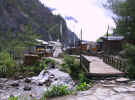 Well
to say the views and mountains were stunning, would be a great
understatement. Trekking in the mountains of Nepal was probably what
most people think a trip around the world is: relaxing, beautiful,
quiet, enchanting villages, old monasteries, fascinating and kind
village people. Well for once the stereotype was true. It was even
double that in our perceptions as we just came out of our 3 month trip
in India where it was like visiting a wild circus act in an oven. I
don’t think there could be 2 more distinctly different experiences of
countries that boarder each other. Thank God we traveled in that order
to enjoy each country that much more. Well
to say the views and mountains were stunning, would be a great
understatement. Trekking in the mountains of Nepal was probably what
most people think a trip around the world is: relaxing, beautiful,
quiet, enchanting villages, old monasteries, fascinating and kind
village people. Well for once the stereotype was true. It was even
double that in our perceptions as we just came out of our 3 month trip
in India where it was like visiting a wild circus act in an oven. I
don’t think there could be 2 more distinctly different experiences of
countries that boarder each other. Thank God we traveled in that order
to enjoy each country that much more.
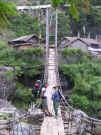 One
of my special favourites about trekking were all of the old
suspension bridges made from wood and rope with snow-capped
mountains towering over the lush green rice fields below. There are
plenty of high gorges and rivers to cross in these canyons between the
mountains. It was really fun walking on the occasionally shaky crossings
300-500 feet above the icy river crashing down below. Real post card
kind of moments, but fortunately no one was around to sell postcards. One
of my special favourites about trekking were all of the old
suspension bridges made from wood and rope with snow-capped
mountains towering over the lush green rice fields below. There are
plenty of high gorges and rivers to cross in these canyons between the
mountains. It was really fun walking on the occasionally shaky crossings
300-500 feet above the icy river crashing down below. Real post card
kind of moments, but fortunately no one was around to sell postcards.
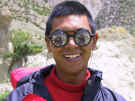 For
the trek, we hired a porter (who was a mountaineer guide slumming it in
the off season) to carry our gear for our 3 week journey into the
mountains. Basically 3 days of clothes, a sleeping bag, and a huge bag
of medicine. About 25 kilos - 55 pounds. Luckily our guide, Lao, was
interested in doing his normal guide stuff and walk with us, instead of
just carrying our gear. He told us of his culture, being born into a
Hindu caste, but switching to Buddhism as it seamed to be a fair system
for him to move up in his life. He also told us of the pain in the ass
tourist that triple load the porters and how his neck was half crooked
his first week as a porter 10 years ago. The porters (basically the same
thing as a “Sherpa” but Sherpa is an ethnic group that porters up
Mt. Everest) in Nepal carry huge loads on their backs which are secured
by a big strap that goes around their forehead and is strapped to the
load behind. So if you can imagine lugging 50 to 100 pounds bent over
attached to a cloth strap to your forehead, wearing sandals (flip
flops), for 3 weeks straight up a mountain in the rain and snow,
that’s the life these people have to make a decent buck. We happened
to put all of our gear in my backpack for Lao to carry and he had on
some good boots, as he knows what to do. For
the trek, we hired a porter (who was a mountaineer guide slumming it in
the off season) to carry our gear for our 3 week journey into the
mountains. Basically 3 days of clothes, a sleeping bag, and a huge bag
of medicine. About 25 kilos - 55 pounds. Luckily our guide, Lao, was
interested in doing his normal guide stuff and walk with us, instead of
just carrying our gear. He told us of his culture, being born into a
Hindu caste, but switching to Buddhism as it seamed to be a fair system
for him to move up in his life. He also told us of the pain in the ass
tourist that triple load the porters and how his neck was half crooked
his first week as a porter 10 years ago. The porters (basically the same
thing as a “Sherpa” but Sherpa is an ethnic group that porters up
Mt. Everest) in Nepal carry huge loads on their backs which are secured
by a big strap that goes around their forehead and is strapped to the
load behind. So if you can imagine lugging 50 to 100 pounds bent over
attached to a cloth strap to your forehead, wearing sandals (flip
flops), for 3 weeks straight up a mountain in the rain and snow,
that’s the life these people have to make a decent buck. We happened
to put all of our gear in my backpack for Lao to carry and he had on
some good boots, as he knows what to do.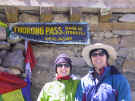
The
climate and terrain change are just incredible, starting at 800 meters
and topping off at 5,4150 meters, which is much higher then most people
sky dive from! It started at tropical rainforest, then to wooded pine
trees with 500 foot waterfalls, then the trees were getting scarcer and
dryer, until we were above the tree line, not far from the snow. The
latitude there was near that of Miami Florida, so the snow line is a bit
higher up than most mountains in the world. We had several rock
avalanches to contend with as we walked on the side of the cliffs. Most
of our time was on a path about 8 feet wide with a sheer drop off to the
river below. Not too bad until the caravan of donkeys came past us with
sacks of freight hanging over their sides. The donkeys have cow bells on
them so you have a few moments to get close to the side and out of the
way. The only way anything is brought up to villages are by these donkey
trains, just as they have been doing for thousands of years. Pretty
cool.
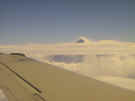 If
Nepal was stunning enough, Julia made it extra special by buying me a
scenic flight out of Kathmandu that
cruised by the peak of Mt. Everest up at 29,035 ft (8850m)! If
Nepal was stunning enough, Julia made it extra special by buying me a
scenic flight out of Kathmandu that
cruised by the peak of Mt. Everest up at 29,035 ft (8850m)!
POLITICAL
SITUATION: The political situation in Nepal last year was a country
under Marital Law to combat terrorist groups attacking the military and
palaces. These are the Maoist rebels, who are part of the local
communist party, that were excluded from the legal process by the
current government. The Nepal government only turned to a constitutional
monarchy about 10 years ago, so there still is a lot of abuse of powers
in the government. In June of 2001, Most of the Royal family was shot
and killed in the palace, reportedly by the prince, heir to the thrown.
He then committed suicide. I have my doubts on that but it really set
the stage for the Maoist troubles.
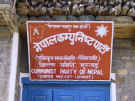 While
we were in India, we had reports of curfews in the cities, to protect
against the Maoist raids, and dozens of rebels getting shot down almost
daily by the military in local outbreaks. What he have learned is that
in many countries, you can’t rely too much on the press. The
government gives “official” statements to the press, which is under
the thumb of the government, then is printed as ordered (suggested).
Other news agencies around the world such as AP, UPI, Reuters, etc pick
these up as is, and then reprint it. But unless you are there first
hand, you don’t know who to believe. Fortunately, we had many friends
we met traveling, that arrived in Nepal ahead of us and gave us their
reports. While
we were in India, we had reports of curfews in the cities, to protect
against the Maoist raids, and dozens of rebels getting shot down almost
daily by the military in local outbreaks. What he have learned is that
in many countries, you can’t rely too much on the press. The
government gives “official” statements to the press, which is under
the thumb of the government, then is printed as ordered (suggested).
Other news agencies around the world such as AP, UPI, Reuters, etc pick
these up as is, and then reprint it. But unless you are there first
hand, you don’t know who to believe. Fortunately, we had many friends
we met traveling, that arrived in Nepal ahead of us and gave us their
reports.
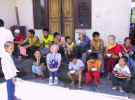 One
of the things that had really moved us on all of our travels was visiting the
Tibetan Refugee Camp in Kathmandu. This is where the refugees are sent
to after they cross the Tibetan boarder. One
of the things that had really moved us on all of our travels was visiting the
Tibetan Refugee Camp in Kathmandu. This is where the refugees are sent
to after they cross the Tibetan boarder. 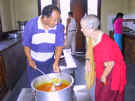 The
refugees have been escaping political persecution from the Chinese government
over the past 40 years. Over 1 million Tibetans have been killed by the
occupying government in Tibet and there are hundreds of political prisoners
sitting in jail, most being monks and nuns, who are the intellectual leaders of
the communities. The Tibetans that escape usually leave in the middle of
the winter crossing over the Himalayans usually walking for 3 months. The
refugees have been escaping political persecution from the Chinese government
over the past 40 years. Over 1 million Tibetans have been killed by the
occupying government in Tibet and there are hundreds of political prisoners
sitting in jail, most being monks and nuns, who are the intellectual leaders of
the communities. The Tibetans that escape usually leave in the middle of
the winter crossing over the Himalayans usually walking for 3 months.
When
the arrive in Nepal many
have severe frostbite and need some amputations. The center we went to
with a Buddhist nun is where they are fed, clothed and medically looked
after. 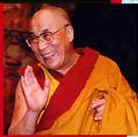 Within a few weeks the refugees are bussed to Delhi, India for
processing and then give refugee status in Dharamsala,
India where they each get to personally meet the Dali
Lama. In Dharamsala they are given the
option of studying to be a monk or nun, or getting academic and job
training. This refugee camp in Kathmandu is where we will be sending some
of our profits from our carpet business. Within a few weeks the refugees are bussed to Delhi, India for
processing and then give refugee status in Dharamsala,
India where they each get to personally meet the Dali
Lama. In Dharamsala they are given the
option of studying to be a monk or nun, or getting academic and job
training. This refugee camp in Kathmandu is where we will be sending some
of our profits from our carpet business.
Bruce and Julia, World Travelers and
Adventure Seekers Extraordinaire.
Copyright © 2003 by [MyWorldTour.org]. All rights reserved.
Revised: 05 Feb 2007 20:21:27 -0600
. |











 Within a few weeks the refugees are bussed to Delhi, India for
processing and then give refugee status in
Within a few weeks the refugees are bussed to Delhi, India for
processing and then give refugee status in